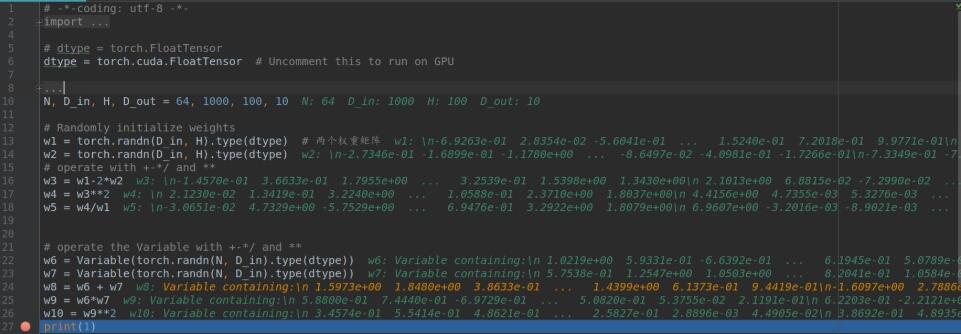FloatTensor与Variable怎么在Pytorch中使用?相信很多没有经验的人对此束手无策,为此本文总结了问题出现的原因和解决方法,通过这篇文章希望你能解决这个问题。
pytorch中基本的变量类型当属FloatTensor(以下都用floattensor),而Variable(以下都用variable)是floattensor的封装,除了包含floattensor还包含有梯度信息
pytorch中的dochi给出一些对于floattensor的基本的操作,比如四则运算以及平方等(链接),这些操作对于floattensor是十分的不友好,有时候需要写一个正则化的项需要写很长的一串,比如两个floattensor之间的相加需要用torch.add()来实现
for step in range(config.total_step): # Extract multiple(5) conv feature vectors target_features = vgg(target) # 每一次输入到网络中的是同样一张图片,反传优化的目标是输入的target content_features = vgg(Variable(content)) style_features = vgg(Variable(style)) style_loss = 0 content_loss = 0 for f1, f2, f3 in zip(target_features, content_features, style_features): # Compute content loss (target and content image) content_loss += torch.mean((f1 - f2)**2) # square 可以进行直接加-操作?可以,并且mean对所有的元素进行均值化造作 # Reshape conv features _, c, h, w = f1.size() # channel height width f1 = f1.view(c, h * w) # reshape a vector f3 = f3.view(c, h * w) # reshape a vector # Compute gram matrix f1 = torch.mm(f1, f1.t()) f3 = torch.mm(f3, f3.t()) # Compute style loss (target and style image) style_loss += torch.mean((f1 - f3)**2) / (c * h * w) # 总共元素的数目?
其中f1与f2,f3的变量类型是Variable,作者对其直接用四则运算符进行加减,并且用python内置的**进行平方操作,然后
# -*-coding: utf-8 -*- import torch from torch.autograd import Variable # dtype = torch.FloatTensor dtype = torch.cuda.FloatTensor # Uncomment this to run on GPU # N is batch size; D_in is input dimension; # H is hidden dimension; D_out is output dimension. N, D_in, H, D_out = 64, 1000, 100, 10 # Randomly initialize weights w1 = torch.randn(D_in, H).type(dtype) # 两个权重矩阵 w2 = torch.randn(D_in, H).type(dtype) # operate with +-*/ and ** w3 = w1-2*w2 w4 = w3**2 w5 = w4/w1 # operate the Variable with +-*/ and ** w6 = Variable(torch.randn(N, D_in).type(dtype)) w7 = Variable(torch.randn(N, D_in).type(dtype)) w8 = w6 + w7 w9 = w6*w7 w10 = w9**2 print(1)
基本上调试的结果与预期相符

看完上述内容,你们掌握FloatTensor与Variable怎么在Pytorch中使用的方法了吗?如果还想学到更多技能或想了解更多相关内容,欢迎关注亿速云行业资讯频道,感谢各位的阅读!
免责声明:本站发布的内容(图片、视频和文字)以原创、转载和分享为主,文章观点不代表本网站立场,如果涉及侵权请联系站长邮箱:is@yisu.com进行举报,并提供相关证据,一经查实,将立刻删除涉嫌侵权内容。